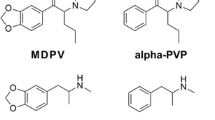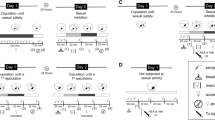Abstract
Rationale
Anabolic steroids are drugs of abuse. However, the potential for addiction remains unclear. Testosterone induces conditioned place preference in rats and oral self-administration in hamsters.
Objectives
To determine if male rats and hamsters consume testosterone by intravenous (IV) or intracerebroventricular (ICV) self-administration.
Methods
With each nose-poke in the active hole during daily 4-h tests in an operant conditioning chamber, gonad-intact adult rats and hamsters received 50 μg testosterone in an aqueous solution of β-cyclodextrin via jugular cannula. The inactive nose-poke hole served as a control. Additional hamsters received vehicle infusions.
Results
Rats (n=7) expressed a significant preference for the active nose-poke hole (10.0±2.8 responses/4 h) over the inactive hole (4.7±1.2 responses/4 h). Similarly, during 16 days of testosterone self-administration IV, hamsters (n=9) averaged 11.7±2.9 responses/4 h and 6.3±1.1 responses/4 h in the active and inactive nose-poke holes, respectively. By contrast, vehicle controls (n=8) failed to develop a preference for the active nose-poke hole (6.5±0.5 and 6.4±0.3 responses/4 h). Hamsters (n=8) also self-administered 1 μg testosterone ICV (active hole:39.8±6.0 nose-pokes/4 h; inactive hole: 22.6±7.1 nose-pokes/4 h). When testosterone was replaced with vehicle, nose-poking in the active hole declined from 31.1±7.6 to 11.9±3.2 responses/4 h within 6 days. Likewise, reversing active and inactive holes increased nose-poking in the previously inactive hole from 9.1±1.9 to 25.6±5.4 responses/4 h. However, reducing the testosterone dose from 1 μg to 0.2 μg per 1 μl injection did not change nose-poking.
Conclusions
Compared with other drugs of abuse, testosterone reinforcement is modest. Nonetheless, these data support the hypothesis that testosterone is reinforcing.




Similar content being viewed by others
References
Alexander GM, Packard MG, Hines M (1994) Testosterone has rewarding affective properties in male rats: implications for the biological basis of sexual motivation. Behav Neurosci 108:424–428
Arnedo MT, Salvador A, Martinez-Sanchez S, Gonzalez-Bono E (2000) Rewarding properties of testosterone in intact male mice: a pilot study. Pharmacol Biochem Behav 65:327–332
Bartke A (1985) Male hamster reproductive endocrinology. In: Siegel HI (ed) The hamster: reproduction and behavior. Plenum Press, New York, pp 74–98
Briscoe RJ, Vanechek SA, Vallett M, Baird TJ, Holloway FA, Gauvin DV (1998) Reinforcing effects of caffeine, ephedrine, and their binary combination in rats. Pharmacol Biochem Behav 60:685–693
Brower KJ (2002) Anabolic steroid abuse and dependence. Curr Psychiatry Rep 4:377–387
Brower KJ, Blow FC, Young JP, Hill EM (1991) Symptoms and correlates of anabolic-androgenic steroid dependence. Br J Addict 86:759–768
Bruning PF, Jonker KM, Boerema-Baan AW (1981) Adsorption of steroid hormones by plastic tubing. J Steroid Biochem 14:553–555
Chu L, Wood RI (2002) Testosterone, dopamine, and food choice in a cost-benefit test with male hamsters. Behav Brain Res 136:137–142
Cicero TJ, O’Connor LH (1990) Abuse liability of anabolic steroids and their possible role in the abuse of alcohol, morphine, and other substances. In: Lin GC, Erinoff L (eds) Anabolic steroid abuse. NIDA Res Monogr 102:1–28
Dai S, Corrigall WA, Coen KM, Kalant H (1989) Heroin self-administration by rats: influence of dose and physical dependence. Pharmacol Biochem Behav 32:1009–1015
DeBeun R, Jansen E, Slangen JL, Van De Poll N (1992) Testosterone as appetitive and discriminative stimulus in rats: sex-and dose-dependent effects. Physiol Behav 52:629–634
DeRoche V, Piazza PV, Deminiere J-M, Le Moal M, Simon H (1993) Rats orally self-administer corticosterone. Brain Res 622:315–320
Doweiko HE (2002) Concepts of chemical dependency. Brooks/Cole, Calif.
Ferguson GA (1966) Statistical analysis in psychology and education. McGraw-Hill, New York
Fingerhood MI, Sullivan JT, Testa M, Jasinski DR (1997) Abuse liability of testosterone. J Psychopharmacol 11:59–63
Friedl KE (1990) Reappraisal of the health risks associated with the use of high doses of oral and injectable androgenic steroids. In Lin GC, Erinoff L (eds) Anabolic steroid abuse. NIDA Res Monogr 102:142–177
Galloway GP (1997) Anabolic-androgenic steroids. In: Lowinson JH, Ruiz P, Millman RB, Langrod JG (eds) Substance abuse: a comprehensive textbook. Williams & Wilkins, Baltimore, pp 308–318
Goldstein PJ (1990) Anabolic steroids: an ethnographic approach. In: Lin GC, Erinoff L (eds) Anabolic steroid abuse. NIDA Res Monogr 102:74–96
Johnson LR, Wood RI (2001) Anabolic steroid abuse: studies in oral testosterone self-administration. Neuroendocrinology 73:285–292
Kashkin KB, Kleber HD (1989) Hooked on hormones? An anabolic steroid addiction hypothesis. JAMA 262:3166–3170
King BE, Packard MG, Alexander GM (1999) Affective properties of intra-medial preoptic area injections of testosterone in male rats. Neurosci Lett 269:149–152
Kritzer MF (1997) Selective colocalization of immunoreactivity for intracellular gonadal hormone receptors and tyrosine hydroxylase in the ventral tegmental area, substantia nigra, and retrorubral fields in the rat. J Comp Neurol 379:247–260
Leshner AI (2000) Anabolic steroid abuse. NIDA Research Report Series, NIH Publication 00-3721
Manzardo AM, Stein L, Belluzzi JD (2002) Rats prefer cocaine over nicotine in a two-lever self-administration choice test. Brain Res 924:10–19
Meisel RL, Sachs BJ (1994) The physiology of male sexual behavior. In: Knobil E, Neill JD (eds) The physiology of reproduction, vol 2. Raven Press, New York, pp 3–106
Mermelstein PG, Becker JB, Surmeier DJ (1996) Estradiol reduces calcium currents in rat neostriatal neurons via a membrane receptor. J Neurosci 16:595–604
Naruse T, Asami T (1987) Intravenous self-administration of diazepam in rats. Eur J Pharmacol 135:365–373
Noble RG, Alsum PB (1975) Hormone dependent sex dimorphisms in the golden hamster (Mesocricetus auratus). Physiol Behav 14:567–574
Packard MG, Cornell A, Alexander GM (1997) Rewarding affective properties of intra-accumbens injections of testosterone. Behav Neurosci 111:219–224
Packard MG, Schroeder JP, Alexander GM (1998) Expression of testosterone conditioned place preference is blocked by peripheral or intra-accumbens injection of α-flupenthixol. Horm Behav 34:39–47
Piazza PV, DeRoche V, Deminiere J-M, Maccari S, Le Moal M, Simon H (1993) Corticosterone in the range of stress-induced levels possesses reinforcing properties: implications for sensation-seeking behaviors. Proc Natl Acad Sci 90:11738–11742
Schmidt EF, Sutton MA, Schad CA, Karanian DA, Brodkin ES, Self DW (2001) Extinction training regulates tyrosine hydroxylase during withdrawal from cocaine self-administration. J Neurosci 21:RC1387(1–5)
Schroeder JP, Packard MG (2000) Role of dopamine receptor subtypes in the acquisition of a testosterone conditioned place preference in rats. Neurosci Lett 282:17–20
Simerly RB (1995) Hormonal regulation of limbic and hypothalamic pathways. In: Micevych PE, Hammer RP Jr (eds) Neurobiological effects of sex steroid hormones. Cambridge University Press, Cambridge, pp 85–116
Wood RI (2002) Oral testosterone self-administration in male hamsters: dose-response, voluntary exercise, and individual differences. Horm Behav 41:247–258
Yesalis CE, Anderson WA, Buckley WE, Wright JE (1990) Incidence of the nonmedical use of anabolic-androgenic steroids. In: Lin GC, Erinoff L (eds) Anabolic steroid abuse. NIDA Res Monogr 102:97–112
Yokel RA (1987) Intravenous self-administration: response rates, the effects of pharmacological challenges, and drug preference. In: Bozarth MA (ed) Methods of assessing the reinforcing properties of abused drugs. Springer-Verlag, New York, pp 1–33
Acknowledgements
We thank Ms. Reshma Karipineni and Mr. Eric F. Schmidt for technical assistance. This study was supported by grants from the National Institutes of Health to R.I.W. (DA-12843 and MH-55034).
Author information
Authors and Affiliations
Corresponding author
Rights and permissions
About this article
Cite this article
Wood, R.I., Johnson, L.R., Chu, L. et al. Testosterone reinforcement: intravenous and intracerebroventricular self-administration in male rats and hamsters. Psychopharmacology 171, 298–305 (2004). https://doi.org/10.1007/s00213-003-1587-7
Received:
Accepted:
Published:
Issue Date:
DOI: https://doi.org/10.1007/s00213-003-1587-7




